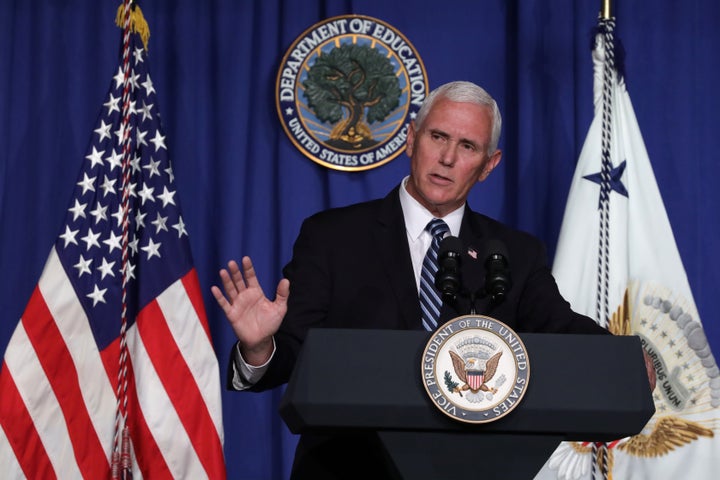The Centers for Disease Control and Prevention will weaken guidelines for reopening schools that President Donald Trump said were too stringent, Vice President Mike Pence said Wednesday.
“The president said today, we just don’t want the guidance to be too tough,” Pence said during a press briefing at the Department of Education. “That’s the reason why next week, the CDC is going to be issuing a new set of tools, five different documents that will be giving even more clarity on the guidance going forward.”
The CDC is under clear pressure from the White House to amend its current nonbinding guidelines for schools, which say, among other things, that teachers and students should wear cloth masks and that desks should be “at least 6 feet apart when feasible.” Trump tweeted earlier Wednesday that he disagreed with the CDC “on their very tough & expensive guidelines for opening schools” and “will be meeting with them!!!” He also threatened to cut off funding to schools if they did not reopen quickly enough, although schools are mostly funded by state and local governments.
At multiple points in the briefing, CDC Director Robert Redfield downplayed his agency’s recommendations by stressing that they “are not requirements” and are “not meant to be prescriptive.”
“Ultimately, it’s not a matter of if schools need to open — it’s a matter of how.”
- Secretary of Education Betsy DeVos
The president has framed continued closures as a sign of political opposition and has downplayed the ongoing threat of the coronavirus, even as the U.S. hit 3 million cases on Wednesday. There is no vaccine for the virus, and testing remains slow and difficult to access in many parts of the country. Reopening schools without adequate safety measures could mean spreading the virus even further and putting students, teachers, school staff members and their families at risk.
Several school districts announcing their tentative reopening plans for the fall have suggested a combination of in-person instruction and “distancing learning” in order to abide by the recommendation that students stay 6 feet apart. New York City, for instance, has said students might physically attend classes only two or three days per week.
Secretary of Education Betsy DeVos has implored schools to reopen full-time in the fall. On a call with governors on Tuesday, she chided a district that plans to open to students for up to two days a week.
“Ultimately, it’s not a matter of if schools need to open — it’s a matter of how. Schools must fully open; they must be fully operational,” DeVos said on the call. She conceded that reopening schools is inherently risky, but said “risk is involved in everything we do, from learning to ride a bike to riding a rocket into space and everything in between.”

Distancing learning has generally not been considered successful ― it’s a major stressor for working parents and a poor replacement for classroom instruction — and kids going to school only a couple of days per week would be a disaster for many working parents already burned out from three months of struggling to teach their kids at home. Being in school is also better for children’s socialization, as the American Society of Pediatrics has noted.
But reopening schools safely is complicated ― and expensive.
School administrators are already facing a major budget crunch due to economic losses during the pandemic, and reopening safely will require a host of costly new procedures. Schools may need more buses to safely transport kids if only one child is allowed per seat. Class sizes may need to be cut in half, requiring more space and teachers. And staff may decide to bring lunch to their classrooms instead of seating kids in a cafeteria, which would likely require more food service workers.
At the same time, some groups are already forecasting that schools may have to lay off hundreds of thousands of teachers and employees amid new budget shortfalls.
Schools also need to contend with how they will monitor and test children for the virus. Dr. Deborah Birx of the coronavirus task force addressed the problem at Wednesday’s briefing, saying saliva tests could be a useful alternative to the swab test many say is uncomfortable. She did not clarify, however, whether such alternative tests would be ready in the coming months, and at scale.
Congress could include funding for schools in its next major coronavirus relief package. A House-passed Democratic bill included $100 billion for coronavirus costs, but Senate Republicans have scoffed at the measure.
Senate Majority Leader Mitch McConnell (R-Ky.) said Monday that he would likely address schools in a bill to be unveiled sometime this month, though he said his top priority is blocking coronavirus-related lawsuits. House Minority Leader Kevin McCarthy (R-Calif.) also said Congress should stop “frivolous lawsuits” and that the Department Health and Human Services should study whether the coronavirus is as transmissible among children as it is among adults.
Randi Weingarten, president of the American Federation of Teachers, told HuffPost this week that “a safe reopening is going to require more money” and that the Senate should approve House-passed legislation.
- Stay up to date with our live blog as we cover the COVID-19 pandemic
- 7 essential pieces of relationship advice for couples in quarantine
- What you need to know about face masks right now
- How to tell if you need to start doing online therapy
- Lost your job due to coronavirus? Here’s what you need to know.
- Parenting during the coronavirus crisis?
- The HuffPost guide to working from home
- What coronavirus questions are on your mind right now? We want to help you find answers.
- Everyone deserves accurate information about COVID-19. Support journalism without a paywall — and keep it free for everyone — by becoming a HuffPost member today.
